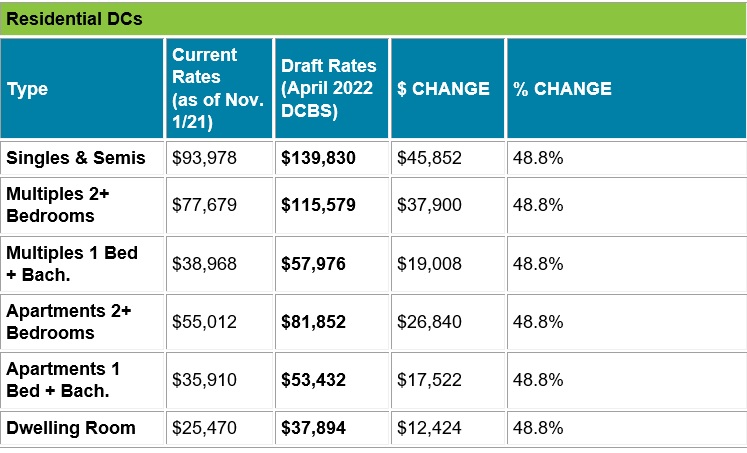Perhaps this could have been included in Monday’s blog as a third tenet, except that this isn’t “new legislation,” nor is it going to kill condominium development.
But before we get to that, I first want expand a little bit on Monday’s blog, as I think it’s important to note that condominium developers didn’t get to where they are by doing stupid things.
As it stands right now, there’s a “great unknown” with respect to inclusionary zoning requirements for new condominiums, and even though developers are in the business of developing, none of them are going to take a chance on the great unknown.
May I please use a sports analogy here?
Thanks!
I am an excellent “armchair quarterback,” as the analogy goes, only with respect to hockey.
I never played at a super-competitive level, but I’m a historian of the game and I am obsessed with the business-side of the sport.
Back in 2003, there was a lockout looming for the 2004-2005 season. I took a university course in 2003 called, “The Economics of Professional Sports,” with the late, great, Dr. Donald Dawson of McMaster University, and he predicted “the mother of all lockouts” – a phrase he repeated over-and-over through the year.
The economics of the National Hockey League were going to change substantially and it would take “at least a year,” Dr. Dawson said.
Nobody thought the NHL would lose a season. Most thought that the NHL wouldn’t lose a game.
On September 16th, 2004, the NHL players were officially “locked out” after two full years of collective bargaining that went absolutely nowhere.
But before that happened, the Toronto Maple Leafs, for some reason, thought it prudent to lock-up 39-year-old goaltender, Ed Belfour.
Why?
Why in the world would the Leafs sign a big new contract, let alone one with an aging goalie, right before the “great unknown” would take place in the NHL?
They had no idea what the new landscape of hockey would look like, and yet they made this move. But what if the owners “won” and salaries came down?
That’s exactly what happened. A salary cap was agreed to for the first time ever, in the history of the NHL, and it would max out at $39 Million per team.
But the Leafs had signed Ed Belfour to a ridiculous 2-year, $16 Million contract, which was actually the highest per-season deal signed in the summer of 2004.
How about that, eh?
With the “great unknown” lurking, the Leafs decided to sign a 39-year-old goaltender to a massive deal, that would pay him through age-41.
Oops!
The 2004-05 season was lost to the lockout, but the next year, in Belfour’s first season back, he went from a GAA of 2.13 in 2003-04 to a whopping 3.29 GAA in 2005-06, and his save percentage dropped from a fantastic .918 to a paltry .892. He also had 10 shutouts in 2003-04, and that number fell to zero in 2005-06.
I watched this contact signing in the summer of 2004 with utter disbelief. I couldn’t understand why the Leafs did this.
But what do I know? I’m just an armchair quarterback…
When we look at the “great unknown” in the city of Toronto with respect to inclusionary zoning by-laws, we can use the parallel of Ed Belfour’s contract, however silly that is, to see how and why a developer would be hesitant to purchase a development site right now.
Sure, developers do take risks now and again. You have to if you want to be successful in this business.
But most developers, believe it or not, look for some level of certainty. When it comes to land assemblies, the reason they buy up houses conditionally is not only because they need all fourteen houses in a fourteen-unit block, and if they can only buy thirteen, they need to walk from the deal, but also because they need time to see if the project is feasible.
A developer isn’t going to drop $40 Million, $80 Million, or $250 Million on a site unless they already know what they can build, what it will cost, and how much money they’re making.
So let’s say we’re working on a land assembly of 14 houses and the first seller accepts a 90-day condition. Now, let’s say that it takes 65 days to get the 14th house sold. With only 25 days left in the conditional period, if that developer can’t find out, with absolute certainty, what he needs to know, he’ll look to extend the conditions, or he’ll walk.
Now, imagine how a developer feels about the “great unknown” of inclusionary zoning by-laws in the fall of 2022, while trying to evaluate condo sites?
It’s just not happening.
Not unless a developer can steal a site.
Nobody is buying out there right now and it’s all because of the changing landscape.
Sure, the Toronto Maple Leafs spent $8 Million per year, for two years, on Ed Belfour before the 2004-05 lockout led to a completely new collective bargaining agreement, whereupon they probably could have signed him for $4-5 Million for one year.
But a developer isn’t going to spend $80 Million on a site that could be worth $80-$120 Million, only to find out down the line that being “forced” to include a percentage of affordable units in the development means the property is only worth $60 Million.
Now having said this, the actual point of today’s blog was supposed to be about development charges in the city of Toronto.
According to the City of Toronto themselves:
Development charges are fees collected from developers at the time a building permit to help pay for the cost of infrastructure required to provide municipal services to new development, such as roads, transit, water and sewer infrastructure, community centres and fire and police facilities.
If you need more information, I recommend watching this very happy-go-lucky video, from the City of Toronto, that espouses all the benefits of “DC’s,” as they’re called:
The video notes that development charges are intended “to build new infrastructure and support growth.” They call development charges a tool for the “recovery of growth costs.”
The video also notes that development charges are intended to “Avoid taxpayers paying for costs that serve growth. Development charges do not pay for operating costs or infrastructure renewal. That’s paid for by new taxes from new homes and businesses, also known as assessment growth.”
I would love to see the City of Toronto’s books, because I’m not sure if you can throw the baby out without the bath water here…
Let’s not forget that the developer pays for a lot of things you might think the municipality pays for, like streets in a subdivision, for example.
Through Bill 108, the “More Homes, More Choice Act,” the government of Ontario apparently made it more difficult and complex for the municipalities to levy and spend development charges, for example, by outlining “ineligible” costs like operating and maintenance costs, which, according to the video below, were never intended to be paid for by development charges.
Those measures came into effect in 2020.
But last month, accompanied by almost zero mainstream media coverage, the City of Toronto announced a 49% increase in development charges, across the board.
Well, 48.8%. Who am I to round up and mislead the public, right?
Here is a look at residential development charges both before and after the proposed change:

I read somewhere that the rationale behind these massive increases was that the city couldn’t increase fees at all during the pandemic.
Right.
So now is the time for a 49% increase?
Late last year, there was a great article about development charges in the Toronto Star:
“Toronto Has $2.6 Billion In Development Charges And Fees Sitting In Reserve, BILD Report Says”
Tess Kalinowski
December 1st, 2021
This article appeared late in the year and I don’t think we dealt with this as a topic.
But now that there’s a 49% increase in development fees pending, suddenly some of the quotes in this article are rather telling!
Municipal fees and charges are by far the largest component of the government-imposed taxes and fees that make up 22 to 24 per cent of the cost of a new home.
Where development charges and fees have risen by as much as 606 per cent in the GTA since 2009, property taxes have increased only 22 per cent, said BILD.
Between 2013 and 2019 the combined development charge reserves of 16 area municipalities grew to $3.25 billion — a $1.3 billion increase — for which the City of Toronto comprised the biggest part. Its reserve balance rose by $839 million in that period, totalling $1.2 billion.
The study found that development charge reserves across the GTA rose 70 per cent between 2013 and 2019 to $3.25 billion — a $1.3 billion increase among all of them.The City of Toronto accounted for the greatest boost in reserves, rising $839 million for a total of $1.2 billion.
Reserves of cash earmarked for parkland rose nearly 300 per cent in the same period to $1.48 billion.
I started ranting about development charges in mid-2021 when this figure – 22 to 24 percent – was noted. Imagine 22 to 24% of the cost of a new representing development charges! As I explained, er, ranted in 2021, when you factor in land transfer tax, this figure is even higher.
So what’s going to happen when development charges increase?
Well, if you ask the City of Toronto, it’s not a big deal!
Toronto Storeys wrote an article last month entitled, “Builders Sound Alarm As Toronto Proposes Huge Increase To Development Charges.”
Yes, Toronto Storeys. Remember when I said that there wasn’t a lot of mainstream media coverage? I mean, I didn’t expect the Toronto Star Editorial Board to meet for mocha frappucinos and come out of a conference room with a scathing report on development charges, but I would have liked to see something!
From the Toronto Storeys article:
Andrew Flynn, Controller at the City of Toronto, says builders’ fears of skyrocketing costs are being taken to the extreme, and that the resulting increase is smaller than perceived.
“If we’re just talking about development charges, the point I would make about affordability is 49% sounds like a big number, but the average change for apartment units is $22,000,” he told STOREYS. “I compare that to the average price of condos just in 2021, they went up by 20% to $800,000. Folks are saying, ‘Forty-nine percent, oh my god, they’re making things unaffordable,’ and I’m going, ‘It’s $22,000 per unit.’
“It’s just another input, like the cost of drywall, the cost of windows that the development community has to consider as part of their pro formas. But the revenue they’re generating is not a one-to-one relationship. A 20% increase on $800,000 is a much bigger dollar number than $22,000 in DC charges.”
The City has indicated that in addition to the five-year requirement to reassess development charges, it must also do so due to “some of the provincial legislative changes that take effect on September 2022” — referring to the province of Ontario’s More Homes More Choice Act – as well as Bill 197, the Covid-19 Economic Recovery Act 2020.
Love this guy! What a great civil servant!
“Sounds like a big number,” he says.
It’s so small, so easy! Just a mere $22,000.
Except that, if we want to play around with numbers, we could note that the average total government charge on a new detached home in Toronto is currently $282,396.
How’s that for a number?
Oh, and some of that figure will include a 49% increase now, right?
No bigs!
The municipality paid a consulting firm called “Hemson” to provide a study on development charges and that whopping 427-page report can be found HERE.
So it’s not as though the City of Toronto proposed this increase in DC’s without a massive undertaking in research and consultation, and yet the point I’m making has not changed, and will not change: real estate is expensive, in part, because of monies paid to various levels of government.
Blog reader A Grant raised a good point in Monday’s blog, asking:
“If various taxes/fees/DC’s are reduced or eliminated altogether, are we saying that developers would then reduce the price of their units by a corresponding amount?”
Exceptionally unlikely.
It’s a hard question to ask, since fees will never go down. I mean, honestly, how do you evaluate a hypothetical that isn’t hypothetical?
I’m of the opinion that if fees were reduced on one level, they’d increase on another level. That’s what I mean in Monday’s post by the “zero sum game.”
But let’s say that a new party of government gained office and cut fees for developers massively and offset this by increasing taxes on people who’s last name starts with the letter “Q.” Would the developers charge less for units, or simply pocket more profit?
The latter, we’re all sure of it.
But as blog reader Kyle points out thereafter, it’s possible that inclusionary zoning simply makes some projects unviable. The example I gave on Monday about the developer who won’t buy a massive 175-foot frontage on prime Yonge Street, for a paltry $80 Million, is a good example of a developer who doesn’t want to take on the risk of lack of viability.
And let’s say this parcel was already owned by a developer. Let’s say that new inclusionary zoning, or some other piece of legislation, made it unviable or “not profitable enough” that the developer didn’t go forward with the project. They might keep the site for a year, or ten, and just sit on it. What good does that do our market that is starving for inventory?
Developers who own land but do not feel it is profitable enough to build will not give the land away, nor will they sell it. They’ll just let it sit.
So come full circle here and the way I see it, increasing development charges on new condos has one of two outcomes:
1) In the event that the project is still viable and the expectation is that the project will sell, the developer will pass the cost on to the consumer, thereby raising the price.
2) In the event that the project is not viable, the developer won’t build, and the land stagnates.
As blog reader A Grant also pointed out, the market could work itself out in the form of a quid-pro-quo. If the developer had forecasted revenues based on an approval for 40-storeys, and the City of Toronto is forcing the developer to build 10% affordable units, then this loss of revenue could be offset by allowing the developer to build 44-storeys.
But how does that work?
How long does that take?
What if neighbours, who fought the 60-storey proposal, to get it down to 40-storeys, now oppose the 44-storey agreement between the city and the developer?
There are lots of ways to see this in a positive light, and some of the readers are more optimistic than me. They see the good. They solve problems. They propose solutions. They believe that humanity will prevail.
I’m not a pessimistic person, and for those who read regularly, you might find that hard to believe. I got into this business and saw nothing but bullshit; everything was positive, agents always pointing out the beautiful granite counter-tops, or pretty crown moulding, and I decided that a contrarian’s voice was needed, and that there was a benefit to pointing out pitfalls, downsides, and headaches. I’m sure the regulars are familiar with the story of how Toronto Realty Blog came to be…
But despite trying to be optimistic about issues that face our city, I can’t see a path here. There’s just not enough money to accomplish everything we want; everything that people want.
The next two years will represent a very interesting litmus test for the condominium construction and sale industry.
With the cost of labour and materials rising rapidly, a declining and aging workforce creating a labour shortage, already sky-high real estate prices, new taxes on assignment-flippers, and a huge increase in development charges, I wonder how inventory levels will look in 2024 and beyond…
































Appraiser
at 10:49 am
Since when has creating uncertainty, while driving up the cost of production, ever resulted in an increase in supply or a decline in prices ?
Asking for a housing crisis.
Paul
at 12:01 pm
Lol @ Ed Belfour
David you have a memory like an elephant
Condodweller
at 5:56 pm
What boggles my mind is that $282k DC would have bought a nice SFH in a nice neighbourhood in Toronto when I got in the market! Somone I knew bought a house near the Danforth for IIRC ~$160k not more than 30 years ago. Someone needs to do the “Hello, McFly” thing with these people. I like to use salaries as a comparison when it comes to these things. That $22k increase was an annual minimum wage not that long ago!
Here’s a thought experiment. Let’s say we have an 89 style crash of about 50%. How much would a house be worth after the DC and all transactional items were taken out?
Regarding would a developer reduce prices if their DC charge went down. I just saw a tweet of a letter some UK politician sent to oil producers after the government reduced taxes to help out the public with gas prices at the pumps and low and behold it was not passed on to the consumers. It was threatening legal action if they don’t follow through.